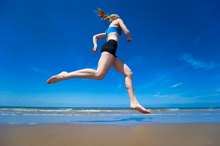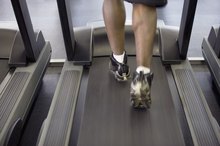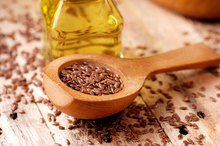What does fact checked mean?
At Healthfully, we strive to deliver objective content that is accurate and up-to-date. Our team periodically reviews articles in order to ensure content quality. The sources cited below consist of evidence from peer-reviewed journals, prominent medical organizations, academic associations, and government data.
The information contained on this site is for informational purposes only, and should not be used as a substitute for the advice of a professional health care provider. Please check with the appropriate physician regarding health questions and concerns. Although we strive to deliver accurate and up-to-date information, no guarantee to that effect is made.
Little Red Dots on My Legs After Exercise
Histamines are released by the immune system as a way to fight off or protect your body from harmful or potentially harmful stimuli. Excessive body heat can be harmful to the body, and when you exercise, your body heat rises. As this occurs, your immune system releases histamines that protect your body from the heat and may cause swelling or redness on particular parts of your body. This histamine release is often referred to as little red dots; MayoClinic.com calls this phenomenon a heat rash or malaria and cholinergic urticaria 12.
Causes
A heat rash can develop on the body whenever the core body temperature rises. This can occur during or after exercise because your sweat ducts become blocked and perspiration traps under your skin. If your skin is hypersensitive to temperature change, transitioning from a cold environment to a warmer environment can cause stress to your body and a heat rash may be the result. Exercise can cause a heat rash because the body quickly changes temperatures.
- A heat rash can develop on the body whenever the core body temperature rises.
- If your skin is hypersensitive to temperature change, transitioning from a cold environment to a warmer environment can cause stress to your body and a heat rash may be the result.
Symptoms
Skin Rashes on Legs Following Exercise
Learn More
The histamine response from the heat rash may range from little red dots to small or larger blistery red lumps. The most common symptom of a heat rash is that the dots or lumps may itch or feel prickly under the skin. Red dots or lumps may appear in skin folds around the armpits, under the knees, below the neck, groin, and arm fold. MayoClinic.com states that a heat rash can also appear under clothes that rub against the skin 1. You can experience a heat rash during or after exercise.
- The histamine response from the heat rash may range from little red dots to small or larger blistery red lumps.
- The most common symptom of a heat rash is that the dots or lumps may itch or feel prickly under the skin.
Treatment
A heat rash does not typically last very long and it usually goes away on its own. The best way to alleviate the symptoms of a heat rash is by allowing time for your skin to cool down. During this time, prevent your skin from sweating because sweating will cause your body temperature to cool down too rapidly. During exercise, wear clothing that is loose-fit and made of cotton. This will protect the body from heat rash by allowing air to flow through the clothes and help cool the body and keep it dry.
- A heat rash does not typically last very long and it usually goes away on its own.
- The best way to alleviate the symptoms of a heat rash is by allowing time for your skin to cool down.
Severity and Duration of Heat Rash
New Rash on Outside of Thighs After a Workout
Learn More
A heat rash is rarely life threatening. Additionally, this condition can be highly variable and long-lasting — experiencing the rash for years can be harmless. You may be able to find treatment regimens that help you control the outbreaks and/or help you treat the rash from exercise. If you experience severe swelling in the areas where the rash forms, you should contact your doctor. In rare cases, a heat rash can cause anaphylactic shock and could be life threatening.
- A heat rash is rarely life threatening.
- Additionally, this condition can be highly variable and long-lasting — experiencing the rash for years can be harmless.
Related Articles
References
- MayoClinic.com; Heat Rash; Jan. 19, 2010
- Cholinergic Urticaria; Chronic Hives Caused by Heat; 2011
- Das S. Prickly heat. Merck Manual Consumer Version. Updated February 2019.
- Guerra KC, Krishnamurthy K. Miliaria. In: StatPearls. Updated December 26, 2018.
- American Academy of Dermatology. 12 summer skin problems you can prevent.
- American Academy of Family Physicians. Heat rash. Updated June 27, 2017.
- Cleveland Clinic. Does your child have a heat rash? Cool it down—here's how. Updated May 26, 2016.
Writer Bio
Stellina Aubuchon has been writing since 2003. She writes on health and communication issues for various websites. Her past writing experience includes her master’s degree thesis on college students' oral health. Aubuchon is working towards her doctoral degree in communication studies, with a specific emphasis in health communication, sensation-seekers and risky behaviors.








